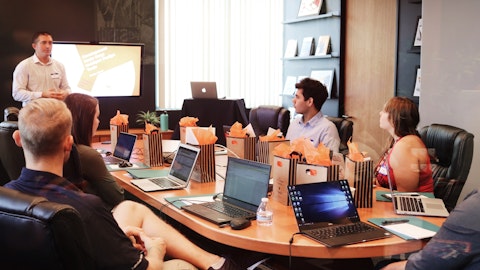ONE Gas, Inc. (NYSE:OGS) Q1 2023 Earnings Call Transcript May 2, 2023
ONE Gas, Inc. misses on earnings expectations. Reported EPS is $1.84 EPS, expectations were $1.86.
Operator: Good day, and welcome to the ONE Gas 2023 First Quarter Earnings Conference Call. Today’s conference is being recorded. At this time, I would like to turn the conference over to Erin Dailey. Please go ahead, Ms. Dailey.
Erin Dailey: Good morning, and thank you for joining us on our first quarter 2023 earnings conference call. This call is being webcast live and a replay will be made available later today. After our prepared remarks, we will be happy to take your questions. A reminder that statements made during this call that might include ONE Gas’ expectations or predictions should be considered forward-looking statements, and are covered by the safe-harbor provisions of the Private Securities Litigation Reform Act of 1995, the Securities Act of 1933, and the Securities and Exchange Act of 1934 each, as amended. Actual results could differ materially from those projected in any forward-looking statements. For a discussion of factors that could cause actual results to differ, please refer to our SEC filings.
Joining us on the call this morning are Sid McAnnally, President and Chief Executive Officer; Caron Lawhorn, Senior Vice President and Chief Financial Officer; and Curtis Dinan, Senior Vice President and Chief Operating Officer. And now I will turn the call over to Sid.
Sid McAnnally: Thanks, Erin. Erin Dailey has stepped into our Investor Relations role, after having served as our Commercial Attorney and also leading the work to stand-up our ESG program, providing her great familiarity with our operations and strategy. Welcome to the team, Erin, and good morning, everyone. As we moved into 2023, our focus remained on executing our strategic plan, enhancing the safety and reliability of our systems, and continuing to reduce emissions. Our first quarter activities and financial results illustrate that we are off to a solid start. On last quarter’s call, I highlighted efforts we undertake to continually analyze system performance and then to pursue solutions, which either enhance or re-enforce our operational capabilities.
Recent weather storms have presented real-life stress-test of our assumptions and our teams have worked to leverage the information gathered from those experiences. In this spirit, last week we approved a new Austin area project, which will greatly expand and diversify the supply portfolio of our Central Texas region, bolster our storage and withdrawal capabilities and ensure we have ample capacity and flexibility to meet the needs of our expanding customer base. Demand for natural gas continues to grow across our footprint and we remain well-positioned to meet this need while prioritizing safety, reliability and environmental responsibility. Now, I will turn it over to Caron to discuss financial details for the quarter, and then to Curtis to review our regulatory and commercial activities before returning to offer final perspectives on our strategy and outlook.
Caron?
Caron Lawhorn: Thanks, Sid and good morning, everyone. I’d like to begin with an update on the securitization of extraordinary gas costs incurred during – on March 23, Texas Gas Service received net proceeds of approximately $197 million from the Texas Natural Gas Securitization Finance Corporation. The completion of securitized financing in Texas marks the end of the securitization process across our service territories. This multi-year process required significant work from our teams, and we thank them for their efforts. It also required close coordination with our regulators and elected officials and support from a broad array of other market participants. We’re pleased to have it successfully concluded and believed it yielded beneficial results for our customers.
Our securitized financing is now complete in all three states. A reminder that the process of Kansas was unique, as the bonds were issued by ONE Gas, special purpose entity that acts as a servicer of the bonds. There is no impact on net income from this arrangement. We provided tables in yesterday’s earnings release that disclosed the balance sheet and income statement impacts, and we’ll continue to provide these disclosures in the future. Turning to our first quarter results. Net income was $102.6 million or $1.84 per diluted share, compared with $98.9 million or $1.83 per diluted share in the same-period 2022. Although, weather across our service territories for the first quarter was 14.5% warmer than the prior year. The impact on earnings was not material due to our weather normalization mechanisms.
First quarter operating income increased $8.4 million or 6% over the same-period last year, reflecting an increase of $17.3 million from new rates, primarily due to interim regulatory filings completed in the second-half of last year and the Texas Gas Service, West-North rate case, which was approved in January. In addition, operating income increased $2 million due to the continued growth in our residential and commercial customer-base, primarily in Oklahoma. Our operations and maintenance expenses increased $11.6 million over the first quarter 2022, due primarily to increases in employee-related costs of $4.1 million, bad debt expense of $2.6 million and outside services of $1.7 million, partially offsetting these increases as a decrease in COVID-19 expenses of $1.6 million.
Depreciation expense was $4.5 million higher than the prior year, reflecting an increase in net property, plant, and equipment as a result of our higher-level of capital investment. Interest expense in the quarter was $14.5 million higher than the same-period in 2022. We issued $300 million of 4.25% senior notes in August and $336 million of securitized utility tariff funds for Kansas in November, both of which contributed to the increase. Our average CP balance outstanding during the quarter is down slightly compared to last year, but the weighted-average interest-rate was higher. It was 4.9% in Q1 2023 versus just 47 basis points in the first quarter of 2022. Relative to our expectations coming into the year, lower natural gas prices will positively impact our investment in gas storage as we refill storage over the next several months.
However, short-term interest rates continue to present a headwind. Our capital expenditures and asset removal costs for the first quarter were approximately $165 million compared to $123 million in 2022. Authorized rate base was approximately $4.48 billion as of March 31, and we estimate our average rate base for 2023 will be approximately $5.12 billion. Turning to our liquidity. We ended the quarter with $720 million of capacity under our $1 billion commercial paper program and no borrowings under our credit facility. In February, Moody’s affirmed our A3 long-term rating and stable outlook. Also in February, we initiated a new three-year $300 million at-the-market equity program to replace our previous program, which expired at same month.
In March, we executed a forward sales agreement for $2 million shares of our common stock, with settlement no later than December 29, 2023, for $1.4 million shares, and by the end of 2024, for the remaining shares. Had all forward shares been settled at March 31, 2023, we would have received approximately $174 million. We believe this derisking of our equity needs positions us well in 2023 and into 2024. Yesterday, the ONE Gas Board of Directors declared a dividend of $0.65 per share, unchanged from the previous quarter. And lastly, we have affirmed our 2023 financial guidance, including net income of $224 million to $238 million, earnings per diluted share of $4.02 to $4.26, and capital investments of approximately $675 million. As Curtis will discuss our outlook for rate base and customer growth remained strong.
Curtis, I will turn it over to you.
Curtis Dinan: Thank you, Caron, and good morning, everyone. I’ll start with a brief update on our regulatory activities. On March 1, we filed our annual performance-based rate change application in Oklahoma, seeking a $27.6 million rate increase to recover $243 million in capital investments and other cost increases. This is our first comprehensive filing using 2022 as a test year and reflects the impact of higher inflation that we experienced last year. As a reminder, our 2021 filing was for $19.7 million. New rates are expected to be implemented in the third quarter. In Texas, we filed the Gas Reliability Infrastructure Program or GRIP for the consolidated West-North region on March 10, seeking $7.4 million to recover costs associated with $54 million in capital investments.
New rates are expected to be effective in July. The Central Gulf GRIP was filed on February 9, seeking an $11.5 million rate increase to recover costs associated with $89 million in capital investments. New rates are expected to be effective in June. Turning to our commercial and operations activities. We remain focused on strengthening our current service capabilities and expanding our system as new residents and businesses move into our region. We continue to scale up our capacity to originate and execute capital projects that support customer growth, as well as system resiliency. To illustrate this, I would like to highlight a couple of projects in the Austin area. First, as Sid discussed in his opening remarks, we are adding interconnections to our Austin System to access additional transportation capacity that we have contracted.
This new capacity will source natural gas supply from the Waha basin, further diversifying our supply portfolio. We are also expanding our contracted storage capacity, enabling us to meet a little more than 50% of our Austin Winter load from storage. These additions will not only enhance our ability to meet Winter demand but also prepare us for continued growth in the Austin area. Another notable project is MoPac Phase II. The final major project identified during our post-incident review from Winter Storm Uri. This project is expected to be completed in the fourth quarter of this year and will enhance current system pressures in Southwest Austin, while also positioning us for growing customer demand. Our teams’ approach to integrating system capacity planning with long-term growth forecast has allowed us to capture more than 50,000 future meter sets during the trailing 12 months or 10.7% ahead of last year at this time.
Additionally, our trailing 12 month meter sets are 5.5% ahead of the pace we saw at the end of the first quarter of 2022. While we continue to see industry-wide inflation affecting material, supply, and labor costs, we are managing these impacts through prudent operating and sourcing strategies. As an example, we recently made some changes to our employee training programs that allow new employees to get qualified and into productive roles more quickly. We have also made some changes in our engineering processes that allowed us to enter our construction season with a more robust backlog of shovel-ready projects. These practices have allowed us to carry-out our plan to capital and maintenance work as we were able to complete approximately $160 million in capital projects this quarter, compared to $130 million in 2022.
We continue to watch economic developments, but remain confident in our ability to execute our capital plan as we move forward in 2023 and start preparing for 2024. I’ll end with a brief update on the execution of our ESG strategy, which is grounded in our overall strategy and aligned with our focus on safety and execution of our capital plan. Expanded disclosures of ESG metrics have resulted in improved scores from ISS and Sustainalytics. These improvements were largely driven by increased disclosures around our management of climate-related risks and opportunities, including investments in tightening our system and increasing safety and system integrity. And now I will turn it over to Sid for closing remarks.
Sid McAnnally: Thank you, both. Our business strategy is straightforward, invest in our assets, develop our team, serve our growing customer-base and create long-term value in an environmentally responsible way. We use our core values to guide the execution of that strategy, and recently saw a confirmation that our coworkers continue their commitment to these values. Safety is our primary core value. And last month, we received notice from the American Gas Association that ONE Gas had the lowest rate of significant injuries among our peers. This recognition of our safety performance is made even more meaningful by the fact that our team has now received this award from AGA for the sixth year in a row. Service is another of our core values.
And we recently received the results of our annual employee engagement survey from Gallup. Once again, we saw that our year-over-year engagement scores improved. The results also clearly indicated that our coworkers strive not only to serve our customers, but also to serve one another. Our focus on safety, system integrity, and environmentally responsible activity, aligns with our new short-term incentive pay metric, that’s tied to the execution of our pipeline replacement and protection program, which also drives our emissions reduction goal. We’ve made steady progress since announcing our emissions reduction goal in January of 2022 and look-forward to giving an update on our progress in our upcoming ESG report this June. In closing, I want to thank our coworkers for their dedication to operating responsible, carrying for one another, and living our core values as they work every day to serve our 2.3 million customers.
Thank you all for joining us this morning. Operator, we’re now ready for questions.
Q&A Session
Follow One Gas Inc. (NYSE:OGS)
Follow One Gas Inc. (NYSE:OGS)
Operator: Thank you. Our first question is from the line of Paul Zimbardo with Bank of America. Paul, please go ahead.
Paul Zimbardo: Hi, good morning, team. Thank you.
Sid McAnnally: Good morning, Paul.
Paul Zimbardo: Thanks. And I was just hoping if you could provide the latest customer bill trajectory just given the pretty significant move in natural gas commodity prices lower, and related if Texas or some of the other states take action with budget surpluses to pay-down securitization opening up further bill headroom. Could that change your spending plans at all?
Sid McAnnally: Yes. Paul, we’re glad to speak to that. I think, Curtis says the latest information on customer bill impact.
Curtis Dinan: Yes. Paul, overall, we averaged just under about $75 on average customer bill, that’s before securitization charges, so that’s service and gas cost.
Paul Zimbardo: Okay. Great.
Curtis Dinan: I’m sorry, Paul. That’s our projection for fiscal year ’23.
Paul Zimbardo: Okay. And if you get relief on the statewide for securitization, could that influence your spending plans at all?
Curtis Dinan: No, we really look at those in different fashion. So we’ve talked before about when we think about the capital for our program — our spending program, it focuses on what the system needs are, and it focuses on what the demand is for growth from customers moving into our areas. So those decisions really drive more of how we think about capital than — if there was not that securitization piece on there, something like that’s appropriate to link those two.
Sid McAnnally: Yes. I mean, Paul, I think it also goes back to comment that Curtis made about the work that we’ve done to try to make sure that we’ve got an inventory of projects that are ready to go. So the work that’s been done to provide project readiness over the top of the year has allowed us this quarter to execute on our capital plan in a meaningful way. And so it’s a much longer-term look than just reacting to the variances that may come quarter-to-quarter. We are optimistic about the capital plan going-forward.
Paul Zimbardo: Okay. That’s a good approach. Now, thank you for that. And then second, just if you had any latest thoughts on Texas legislative priorities as the sessions wind-down and just overall legislative updates across the footprint, that’d be helpful. Thank you.
Sid McAnnally: So a couple of bills that we are watching closely, one has to do with the statewide energy efficiency program in Texas. We do have energy efficiency programs in pockets of Texas today, but not a statewide programs. So we really see that as a very positive bill for the customers and for what we’re trying to do from an environmental perspective. There is still a bill in Texas that would take some funding and perhaps repay the securitization debt. It has been somewhat dormant for a period of time, but it is technically still alive. So we’re watching that one as well. We have a damage prevention bill in the State of Kansas that we’re watching, and so that appropriate those three that I just mentioned at the top of the list as we think about the legislative session this year.
Paul Zimbardo: Okay. Great. Thank you very much, team. I appreciate the time.
Sid McAnnally: Thank you, Paul.
Operator: Thank you. The next question is from the line of Shar Pourreza with Guggenheim Partners. Shar, your line is now open.
Jamieson Ward: Hi, guys. It’s James Ward here on for Shar. How are all of you today?
Sid McAnnally: We are well, James. Hope you are as well.
Jamieson Ward: Absolutely. Thank you for taking our questions here. First one was, we’ve seen obviously half a dozen your peers issue, cash paid converts or basically a modified version of converts recently, in order to lock in a lower interest-rate and lower coupon, is that something that might appeal? Do you guys — is it something that we could see from you in the future? Just wanted to get your thoughts on that vehicle.
Caron Lawhorn: Good morning. This is Caron. Yes, we are always looking at alternatives to our current approach to financing our business. If you look at the companies who had issued converts in the past, I believe all of them in our space have holdcos, which as you probably know, we do not. And so, I think that causes us to think about it a little bit differently. So we do consider it, but don’t have any plans to take advantage of that at this point in time.
Jamieson Ward: Got you. Okay. Thank you for that. And then the second question is just on equity. Should we assume going-forward that forward sales will get continued to be a part of the equity financing strategy, just allowing a bit more control over the timing of share count and so on? Or should we expect that the ATM will kind of takeover here as your primary or only means of equity financing throughout the rest of the forecast period, now that you filed the new one?
Sid McAnnally: James, I think what you’ve seen from us is really an opportunistic approach to how we think about equity. You’ve seen us use effectively an ATM, including forward sales. You’ve also seen a block trade issue that Caron reviewed. We think we’ve had success with those two mechanisms and intend to continue to keep that level of flexibility.
Jamieson Ward: Perfect. Thank you. Very clear. I appreciate that. If it’s all right, I have one more.
Sid McAnnally: Go ahead.
Jamieson Ward: I just wanted to get a sense of — Thank you. Thank you. How you are tracking relative to your rebased guide just with some of the interest and inflation headwinds that you’ve seen? Obviously, those were — two of the core things that you highlighted, when you revised guidance in November there. Have some of those pressures been moderating, and if you could just elaborate as you see that?
Sid McAnnally: Yes. James, really our — if you think back to our guidance and the conversations that we had around the November, December timeframe, what we were reacting to and pointing to were the impacts that the external environment brought to our business. We’ve not seen any changes in the core strategy of the business or our base-case, that as we said, is really focused on robust system integrity opportunities and a meaningful growth opportunity, which we continue to see in our service territory. We are watching inflation with everyone else. Of course, now we have the benefit of having some experience where in November of ’21, as we’ve built the ’22 plan we were at 17 basis points and finished a year later around 425.
I mean, now we’ve got a more stable environment and we’ve been able to plan into that. I think we were conservative in our estimates as we shared with you all in guidance earlier and we’re absorbing those challenges in the same way that our peers are, and that’s by trying to be efficient in the execution of our work and thoughtful as we look at future investments. But the one thing I want to underscore and this was in our prepared comments, is that we are focused on long-term value-creation and we will not sacrifice the opportunities that we are confident. lie ahead of us, as we face these short-term headwinds will be responsible in the way that we address those. But we really like our service territory and we really like the opportunities that it presents for us.
So we are optimistic about the future and we’ll be prudent in the way that we address the present.
Jamieson Ward: That’s terrific. Very clear. Thank you very much for answering the questions.
Sid McAnnally: Yes, thank you for your questions.
Operator: Thank you. The next question from the line of Christopher Jeffrey with Mizuho Securities. Christopher, please go ahead.
Christopher Jeffrey: Hi, everyone. Thanks for taking my question. Maybe just to start with the Austin and MoPack projects. I’m just wondering, — if I missed it, sorry. If there is any impact for capex guidance for this year or maybe the cadence? How you’re thinking about that? Thanks.
Sid McAnnally: That project was part of our capital guidance for the year. It’s not in addition to, it was a project we had contemplated. As we were wrapping up, the work from several projects we had identified coming out of Winter Storm Uri.
Christopher Jeffrey: Great. Thank you. And then, maybe just an update, Curtis, on the RNG Austin projects. Is this was filed in December?
Curtis Dinan: Yes. We — you’re talking about the filing we did in Oklahoma, that filing is still active. There’s a couple of items, including our PBR and some other regulatory filings that are in front of that, but that is at the commission at this point, and we would still anticipate it being completed later in this calendar year.
Christopher Jeffrey: Got it. Thanks. And then, maybe just one more, kind of looking at O&M trend of that 5%, and I think you’ve mentioned before that it’s a bit more front-loaded, which seem to be the case this quarter, kind of — Is there any color on the visibility of where you see that start abating a bit in future years, just anything in particular? And maybe also just part of that, is it some part more of those COVID-19 protocol or costs going to come rolling-off that we’ve seen in recent quarters?
Caron Lawhorn: This is Caron. So the latter part of your question, yes, the COVID-19 costs are rolling-off that that was something that we have considered as we thought about our O&M for the year. And just a reminder, we’re growing. So we are adding customers, we are adding a lot of infrastructure and we are continuing to build capacity and capabilities to serve all these new customers and new assets. We are also strategically in-sourcing work that was previously performed by contractors. So we’re making an investment in hiring and training new employees before we can transition work away from the contractors. And then, obviously, we’re still dealing with the effects of inflation. So all of that was really contemplated in our guidance for this year.
And as you pointed out, we also indicated that we’re going to be a little bit higher than our long-term target over the next couple of years. We don’t really see that any differently. Inflation hasn’t really subsided yet. As Curtis mentioned, we are managing with strategic sourcing and how we’re looking at accessing contractors and laborers and all that. So, I think we’re doing the right things, and don’t really have an update beyond that at this point.
Christopher Jeffrey: Great. Thanks, guys. Thanks, everyone.
Sid McAnnally: Thank you for your questions.
Operator: Thank you. Now, I’d like to hand the call back over to the management for any closing or additional remarks.
Erin Dailey: Thank you all again for your interest in ONE Gas. Our quiet period for the second quarter starts when we close our books in early July and extends until we release earnings in late July. We’ll provide details on the conference call at a later date. Have a great day.
Operator: This concludes the ONE Gas 2023 first quarter earnings conference call and webcast. You may now disconnect.





